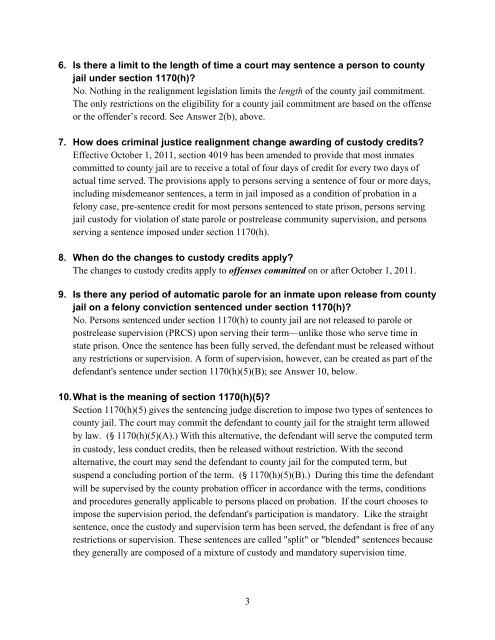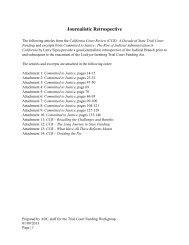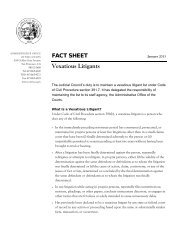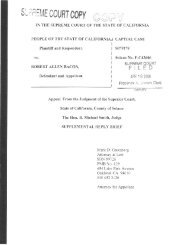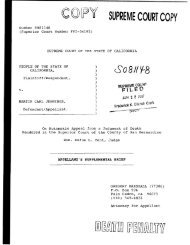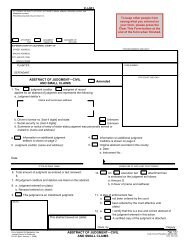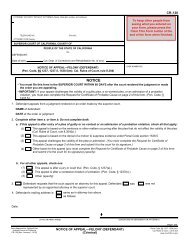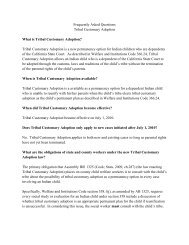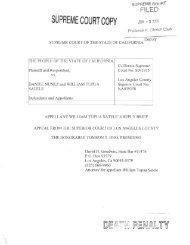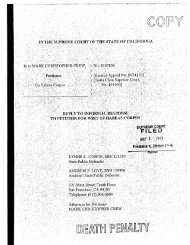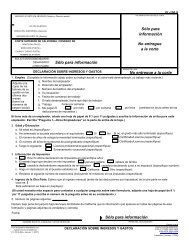2011 Criminal Justice Realignment Act ... - California Courts
2011 Criminal Justice Realignment Act ... - California Courts
2011 Criminal Justice Realignment Act ... - California Courts
Create successful ePaper yourself
Turn your PDF publications into a flip-book with our unique Google optimized e-Paper software.
6. Is there a limit to the length of time a court may sentence a person to county<br />
jail under section 1170(h)?<br />
No. Nothing in the realignment legislation limits the length of the county jail commitment.<br />
The only restrictions on the eligibility for a county jail commitment are based on the offense<br />
or the offender’s record. See Answer 2(b), above.<br />
7. How does criminal justice realignment change awarding of custody credits?<br />
Effective October 1, <strong>2011</strong>, section 4019 has been amended to provide that most inmates<br />
committed to county jail are to receive a total of four days of credit for every two days of<br />
actual time served. The provisions apply to persons serving a sentence of four or more days,<br />
including misdemeanor sentences, a term in jail imposed as a condition of probation in a<br />
felony case, pre-sentence credit for most persons sentenced to state prison, persons serving<br />
jail custody for violation of state parole or postrelease community supervision, and persons<br />
serving a sentence imposed under section 1170(h).<br />
8. When do the changes to custody credits apply?<br />
The changes to custody credits apply to offenses committed on or after October 1, <strong>2011</strong>.<br />
9. Is there any period of automatic parole for an inmate upon release from county<br />
jail on a felony conviction sentenced under section 1170(h)?<br />
No. Persons sentenced under section 1170(h) to county jail are not released to parole or<br />
postrelease supervision (PRCS) upon serving their term—unlike those who serve time in<br />
state prison. Once the sentence has been fully served, the defendant must be released without<br />
any restrictions or supervision. A form of supervision, however, can be created as part of the<br />
defendant's sentence under section 1170(h)(5)(B); see Answer 10, below.<br />
10. What is the meaning of section 1170(h)(5)?<br />
Section 1170(h)(5) gives the sentencing judge discretion to impose two types of sentences to<br />
county jail. The court may commit the defendant to county jail for the straight term allowed<br />
by law. (§ 1170(h)(5)(A).) With this alternative, the defendant will serve the computed term<br />
in custody, less conduct credits, then be released without restriction. With the second<br />
alternative, the court may send the defendant to county jail for the computed term, but<br />
suspend a concluding portion of the term. (§ 1170(h)(5)(B).) During this time the defendant<br />
will be supervised by the county probation officer in accordance with the terms, conditions<br />
and procedures generally applicable to persons placed on probation. If the court chooses to<br />
impose the supervision period, the defendant's participation is mandatory. Like the straight<br />
sentence, once the custody and supervision term has been served, the defendant is free of any<br />
restrictions or supervision. These sentences are called "split" or "blended" sentences because<br />
they generally are composed of a mixture of custody and mandatory supervision time.<br />
3


